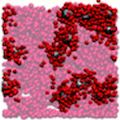Abstract
Polymer nanocomposites are an important class of materials due to the nanoparticles’ ability to impart functionality not commonly found in a polymer matrix, such as electrical conductivity or tunable optical properties. While the equilibrium properties of polymer nanocomposites can be treated using numerous theoretical and simulation approaches, in experiments the effects of processing and kinetic traps are significant and thus critical for understanding the structure and the functionality of polymer nanocomposites. However, simulation methods that can efficiently predict kinetically trapped and metastable structures of polymer nanocomposites are currently not common. This is particularly important in inhomogeneous polymers such as block copolymers, where techniques such as solvent vapor annealing are commonly employed to improve the long-range order. In this work, we introduce a dynamic mean field theory that is capable of predicting the result of processing the structure of polymer nanocomposites, and we demonstrate that our method accurately predicts the equilibrium properties of a model system more efficiently than a particle-based model. We subsequently use our method to predict the structure of block copolymer thin films with grafted nanoparticles after solvent annealing, where we find that the final distribution of the grafted nanoparticles can be controlled by varying the solvent evaporation rate. The extent to which the solvent evaporation rate can affect the final nanoparticle distribution in the film depends on the grafting density and the length of the grafted chains. Furthermore, the effects of the solvent evaporation rate can be anticipated from the equilibrium nanoparticle distribution in the swollen and dry states.
